I know what you’re thinking. Does the world really need another protein smoothie recipe? Yes! Because this is the only one you’ll ever need.
Rather than giving you one more list of highly specific ingredients that you’d need to run out to the store for, I’m going to instead give you a template that you can adjust to fit your own personal needs, taste, and pantry.
Curious about the best blenders for making smoothies? Check out my detailed review of three top models.
You don’t have to use a fancy blender though. I used a relatively inexpensive Nutribullet to whip up this delicious blueberry smoothie below.

It’s my goal that this will be the last protein smoothie recipe you ever need! So let’s get on to the ingredients, the options, and some of my favorite combinations.
How to make a protein smoothie that will actually help you lose weight
If you want to shed some pounds, your protein smoothie needs to check a few boxes. Right off the bat, we need this smoothie to be low or low-er calorie. To me, that means less than 500 calories.
I’ll show you ways to add or subtract calories to fit your own personal dietary needs. The basic recipe template shown below will make a smoothie that clocks in at about 350 or fewer calories.
Next, we need this smoothie to be full of healthful, nourishing ingredients that your body needs to function optimally. Here’s what that means to me: real, whole foods. We want fruits, vegetables and/or greens, plenty of natural fiber, vitamins, minerals, and some healthy fats as well.
Taking things a step further, it’s important that we have a good balance of healthy fats along with moderate protein and moderate carbohydrates. Ideally, we don’t want any one of these macros to be sky-high, but if the carbs are high and they all come from nature (read: fruit), we’re still on track. It’s like I always say: everything in moderation, including moderation.
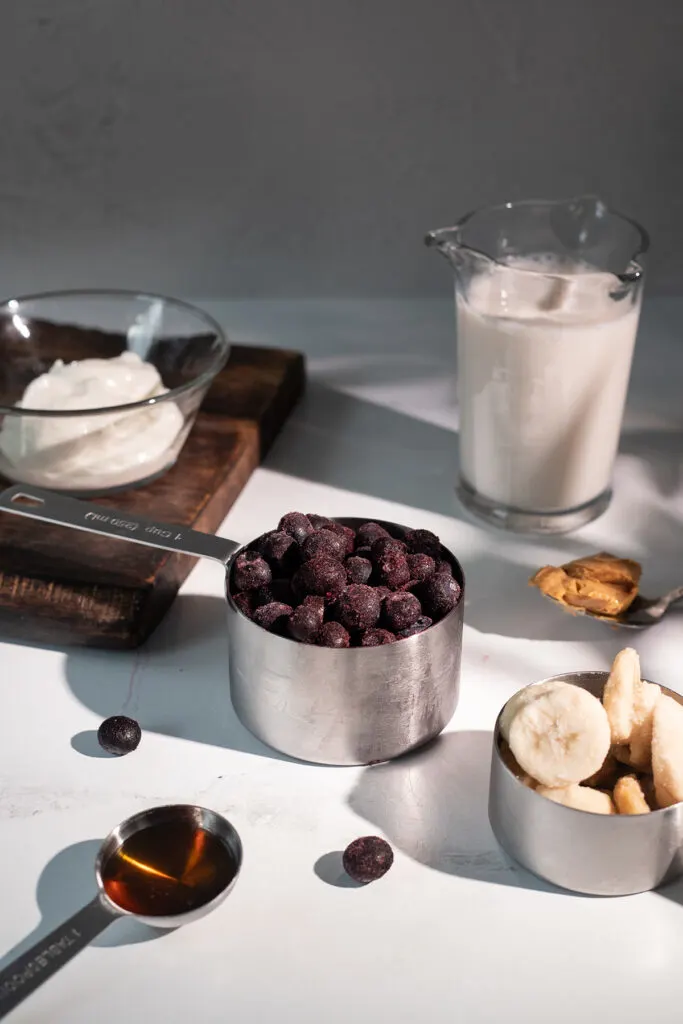
For a smoothie to assist in weight loss, it really needs to keep you feeling full and satisfied for as long as possible. Healthy fats, protein, and fiber are the key. If your smoothie is just a mix of powder and milk, you will likely be tempted to have a snack sooner than later.
Our goal is to make a delicious protein smoothie that will help you eat less and make healthier choices when it’s time for the next meal. And making it should become second-nature.
Who wants to fumble around with their phone looking for a complex recipe that’s buried under ads when all they want is a quick and healthy smoothie?
Oh, and it also needs to taste good. Like, really good. Otherwise, why would you want to drink it? I like my weight loss smoothies to be sweet, creamy, and pretty thick. If you like yours less spoon-able, you can always add a bit more liquid.
The best smoothie ingredients for weight loss
Now that you understand the foundation of a healthy weight loss protein smoothie, we can get into the different categories of ingredients.
From here, it’s basically choose-your-own-adventure. Select one from each category, add everything to the blender, and you’re on your way!
Protein
One of the most important ingredients is our protein. The easiest way to add protein to smoothies is to use a packaged protein powder. However, this typically means adding a lot of other things to your smoothie as well.
Be aware of any artificial sweeteners and sugars that are in your protein powder of choice. If you want a completely natural option, try one from Tera’s Whey.
I most frequently choose a mix of sweetened and unsweetened vanilla Orgain, which is available at most grocery stores as well as on Amazon.
What is the best protein powder flavor for a smoothie?
The best flavor of protein powder for a smoothie is definitely vanilla. Vanilla goes great with every kind of fruit and it’s a natural pairing with any type of milk. Plain is a great second choice, and chocolate is a good third option. Chocolate goes well with most smoothie ingredients, but I find vanilla to be the most versatile protein powder flavor.
If using protein powder, go by the serving size recommended on the package. It’s usually 1-2 scoops.
If you’d rather not use a processed powder, you can also use yogurt. I love a creamy yogurt smoothie, and it also has the benefit of adding all of those probiotics for gut health. When protein is a factor, choose a Greek yogurt or other strained variety of yogurt like skyr or even quark.
If using greek yogurt, use ½ cup.
Silken tofu is another great way to add protein to your smoothies. Soy products are some of the most notoriously genetically modified, however, so choose an organic one. Also be aware that soy should be consumed in moderation (like anything, really).
If using silken tofu, use 6-8 ounces, or roughly ½ cup.
Another protein option is to add nuts or nut butter. However, when we add nuts, we’re also adding quite a bit of fat (which means quite a few calories). Use only real, unsweetened, added oil-free nut butters and in small quantities.
If using nut butters for your protein source, use 2-3 tbsp and skip the healthy fats category below.
- Protein powder
- Greek yogurt (or skyr or quark)
- Silken tofu
- Nuts or nut butter
Want even more ideas? Check out these 18 Protein Powder Alternatives
Healthy fats (1 tbsp)
If using nut butter, your smoothie will have enough fat to keep you feeling full. If not, you’ll want to add a healthy fat such as avocado, coconut oil, or seeds. I love to use a ground mix of chia and flaxseeds for their combination of healthy fats and high fiber.
Frozen diced avocado is an excellent smoothie ingredient that adds healthy fat and a wonderful frozen, creamy texture without altering the flavor.
- Nut butter
- Frozen avocado chunks
- Coconut oil
- Flax seeds
- Chia seeds
Frozen fruit (1 cup+)
This is key for adding flavor, sweetness, some fiber, and a great frozen texture. In addition to berries, peaches, or a frozen fruit medley, I always add half of a frozen banana to my smoothies for the unbeatable creaminess it adds. It also adds plenty of sweetness. Choose 1 – 1 1/2 cups of frozen fruit. You can add the banana in addition to your cup of fruit.
The best frozen fruits for weight loss are berries. They have fewer carbohydrates while still being packed with antioxidants, fiber, and vitamin C.
Frozen fruits I avoid in my smoothies are blackberries and pomegranate arils. No matter how amazing your blender is, there will always be hard little seeds in your smoothie that then end up in your teeth. For this reason, I don’t usually recommend frozen mixed berries. It’s like 70% blackberry seeds! Here are some great options:
- Strawberries
- Blueberries
- Raspberries
- Peaches
- Pineapple
- Mango
- Dark cherries
Milk or other liquid (1 cup – 1 ½ cups)
Unsweetened almond milk is a classic weight loss protein smoothie ingredient. It adds very few calories or sugar while adding a bit of creaminess. You can also use whole milk, skim milk, coconut milk, or oatmilk. Any milk that you enjoy that is unsweetened will be a great option. Just keep in mind that some milks have a lot more fat than others (which translates to more calories).
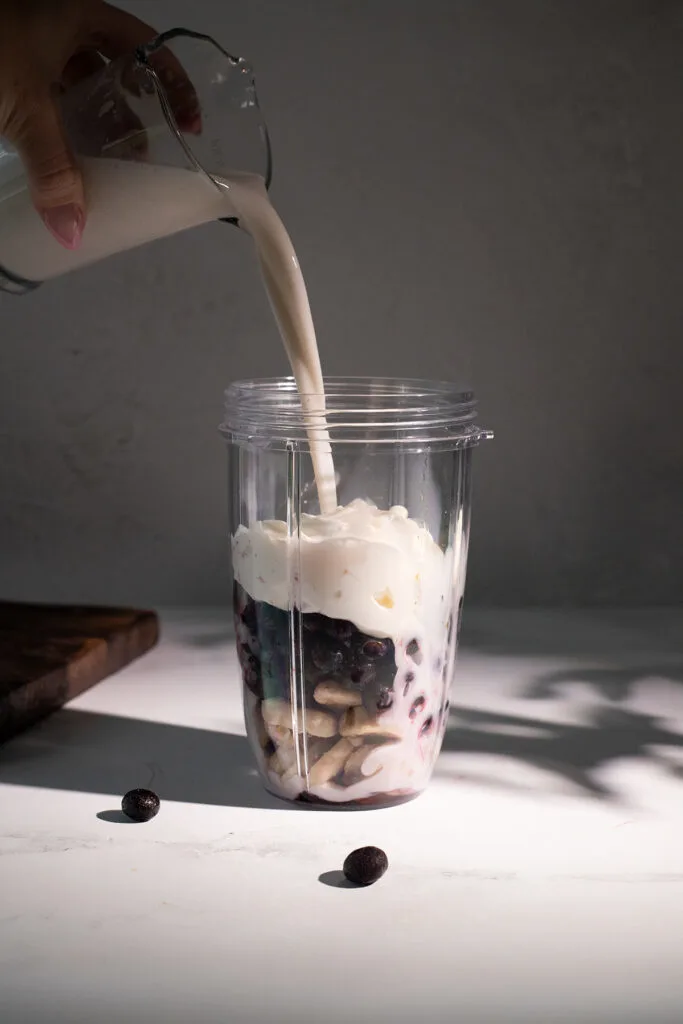
If you don’t want to use milk, you can also use plain water. If you’re using frozen banana, your smoothie will still be creamy and thick. Fresh pressed fruit juices, especially green juice, is another good smoothie liquid option.
- Almond milk
- Whole milk
- Skim milk
- Coconut milk
- Oatmilk
- Water
- Green juice (unsweetened)
Greens, supplements, and other add-ins (optional)
Speaking of greens, they are an excellent add-in for protein smoothies. Greens add tons of nutrients and additional fiber as well as iron without adding a lot of carbs or calories. You can use fresh or frozen greens or a greens powder made specifically for smoothies. I like this one. Add up to 1 cup of fresh greens.
Other great smoothie add-ins are superfood powders that add phytonutrients, vitamins, and minerals to your drink.
If you want to add a bit of caffeine to your smoothie while also adding healthful polyphenols and other antioxidants, add 1 teaspoon of matcha powder. Matcha’s plant powers have been shown to be helpful in weight loss time and again.
Sweetener, to taste (optional)
Now that you’ve assembled a brilliant, nourishing protein smoothie, let’s be cautious with sweeteners. I wouldn’t recommend using white sugar or simple syrup. Instead, I opt for a low calorie, zero-carbohydrate sweetener that won’t upset my digestion.
I love to use allulose or allulose syrup (which is easy to buy in the grocery store!) to give my smoothies a little extra sweet without the negatives of sugar or artificial sweeteners.
If you want a closer-to-nature sweetener, honey, maple syrup, and date syrup are excellent choices. Date syrup is a particularly good option for weight loss because it has a low glycemic index. This means that it doesn’t spike your blood sugar quite the same as other sweeteners.
If using a powdered sweetener, start with 1-2 tsps. If using liquid, start with 1 tbsp and go from there.
- Allulose
- Erythritol
- Monk fruit
- Stevia
- Honey
- Maple syrup
- Date syrup
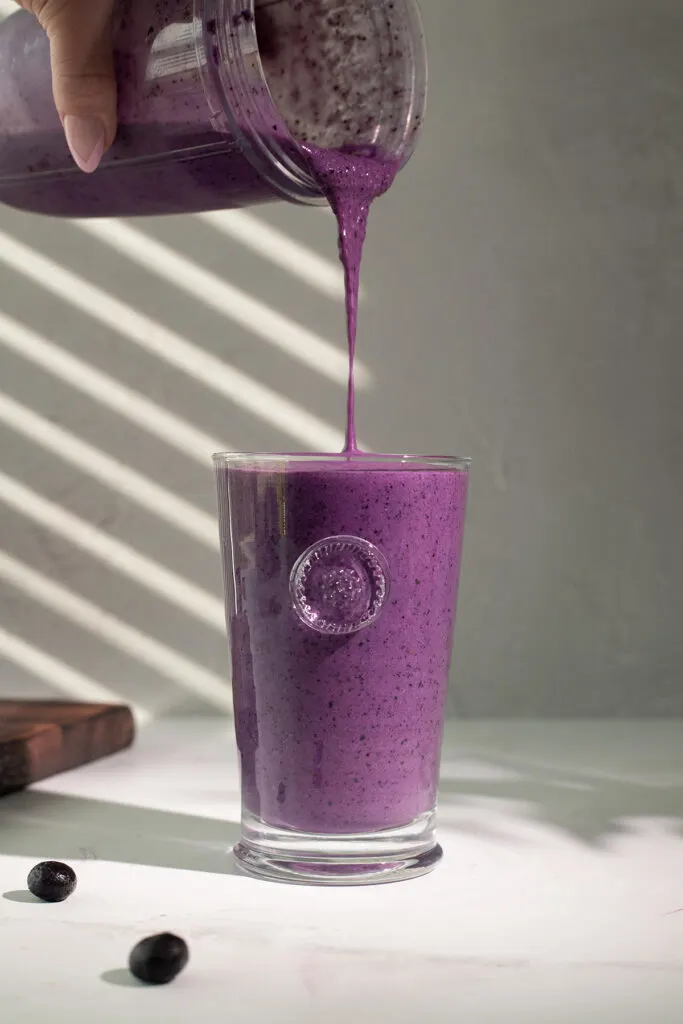
How to customize your calorie count
Need fewer calories? Skip the ½ frozen banana and use water in place of milk. This will immediately shave off around 100 calories. Choose the lowest calorie fruits such as raspberries and strawberries. And skip adding a sweetener unless it’s a zero-calorie or very low calorie option.
Need more calories? Add an extra tablespoon of healthy fats. 1 tbsp of coconut oil is a great choice and it will add about 100 extra calories. When adding calories to a smoothie, choose beneficial, natural fats and carbs rather than additional protein powder.
Protein weight loss smoothie recipe template
I hope these smoothie ingredient lists are helpful and make it easier to whip up protein smoothies at home with what you already have on hand. Here’s a quick breakdown of the 4 essential components for your smoothie, plus the two optional categories:
- Protein (2 scoops powder or ½ cup yogurt)
- Healthy fat (1 tbsp)
- Frozen fruits (1 cup + ½ banana)
- Milk or other liquid (1 – ½ cups)
- Add-ins (1 tsp)
- Sweetener (1 tsp – 1 tbsp)
For some inspiration to get you started, here are two sample recipes that I often make following my protein smoothie recipe template.
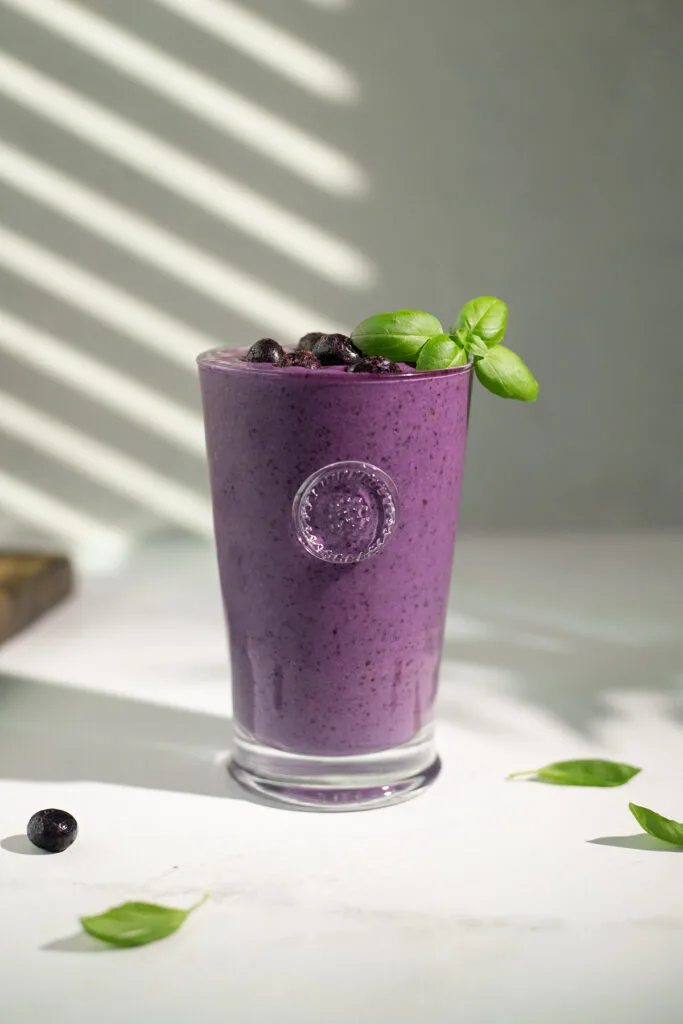
Blueberry Yogurt Protein Smoothie
- ½ cup vanilla Greek yogurt
- 1 cup blueberries
- ½ frozen banana
- 1 cup almond milk
- 1/2 – 1 tbsp maple syrup
- 1 tbsp peanut butter
Calories: 332
Fat: 12 grams
Carbs: 50 grams (net 42 grams)
Fiber: 8 grams
Protein: 15 grams
Strawberry Peach Protein Smoothie
- 2 scoops vanilla protein powder
- 1 cup strawberries and peaches
- ½ banana
- 1 cup water
- 1 tbsp ground chia flax seed blend
Calories: 348
Fat: 10 grams
Carbs: 49 grams (net 39 grams)
Fiber: 10 grams
Protein: 24 grams
You might enjoy these other smoothie recipes:
- Angel Food Smoothie King Recipe (Copycat)
- Pineapple Surf Smoothie King Recipe (Copycat)
- Keto-Friendly Raspberry Smoothie Recipe
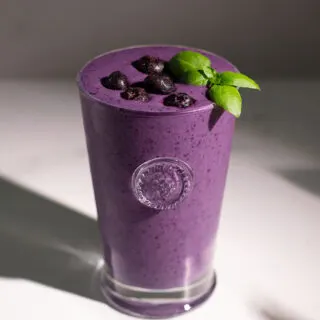
Protein Smoothie Recipe Template (for Weight Loss)
Equipment
- 1 Blender
Ingredients
- ½ cup vanilla greek yogurt OR 2 scoops vanilla protein powder
- 1 cup frozen fruit I used blueberries
- ½ – 1 frozen banana
- 1 cup unsweetened almond milk or other milk of choice
- ½ – 1 tbsp maple syrup, or other sweetener of choice optional
- 1 tbsp natural peanut butter optional
Instructions
- Combine all ingredients in a blender and blend until smooth.
- Pour into a tall glass and top with a few frozen blueberries, if desired.
Notes
- Protein (2 scoops powder or ½ cup Greek yogurt)
- Healthy fat (1 tbsp)
- Frozen fruits (1 cup + ½ banana)
- Milk or other liquid (1 – 1 ½ cups)
- Add-ins (1 tsp)
- Sweetener (1 tsp – 1 tbsp)
